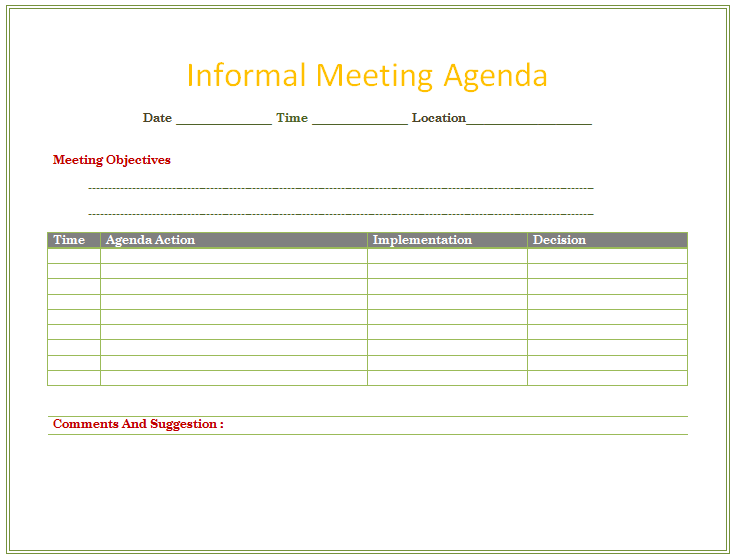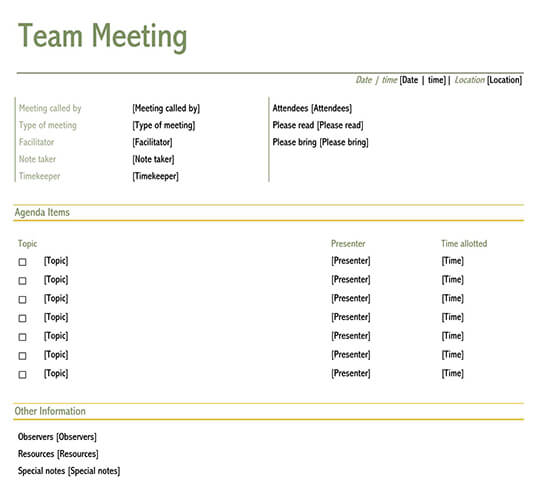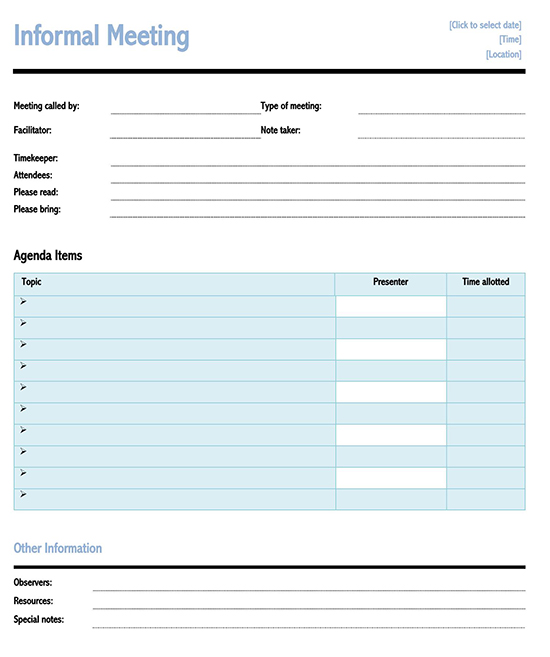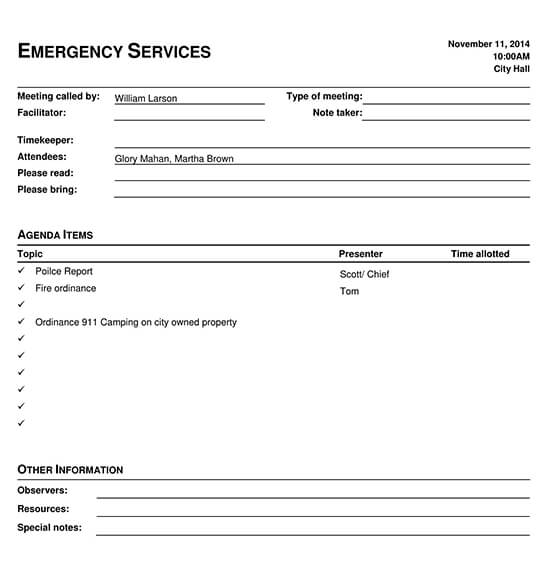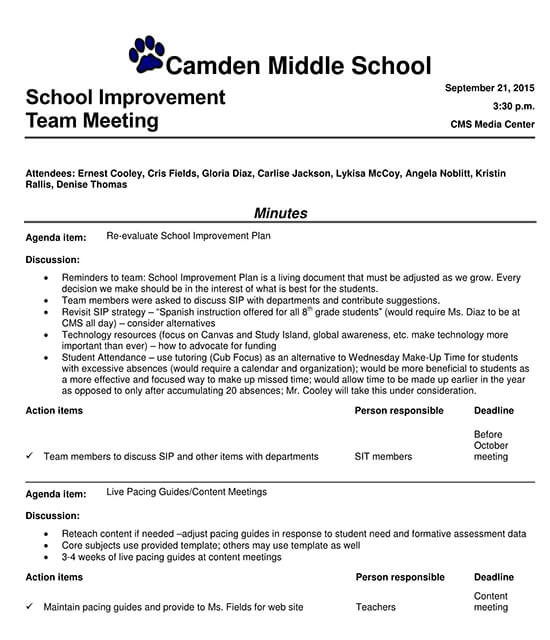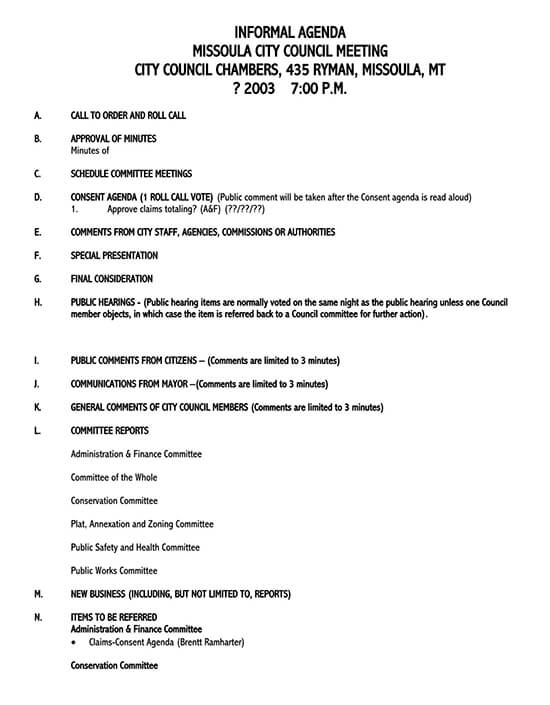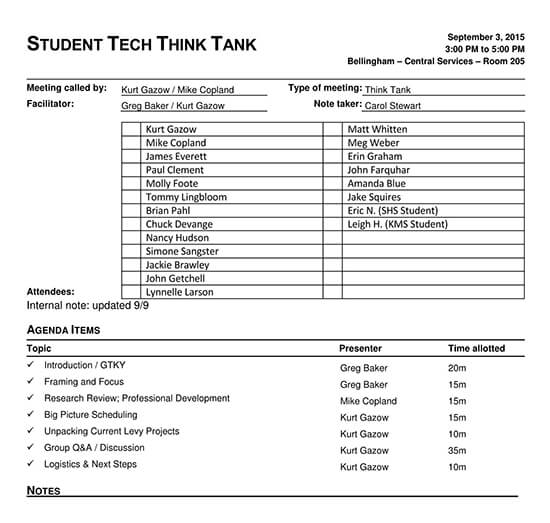An informal meeting is a meeting that is less planned for and less regulated, unlike a formal meeting. An informal Agenda may not include some of the defining features like minutes, a chairperson, and a set agenda, which are a must for a formal meeting. Informal meetings usually take place in a casual setting such as a coffee shop or a restaurant or at one of the participant’s places of choice, unlike in a formal meeting where the meetings are usually conducted in boardrooms.
Informal meetings can be compared to a coach having a quick and opportune chat with their team during the non-playing period about issues that may or may not directly relate to sports but are relevant to the players or the coach.
Purpose of an Informal Meeting
The primary goal of an informal meeting is to discuss issues that would not be considered appropriate in a formal meeting. Such meetings are usually designed to make the participants feel at ease and at liberty to speak their minds than they would in a formal meeting.
When conducting an informal meeting, it is important to know how to write the meetings’ agenda.
An agenda also referred to as a docket or a schedule, is a list of all the activities in the order in which they are to be taken from the beginning until the end of the meeting. An agenda helps one prepare for a meeting as it provides a comprehensive list of items and a clear set of topics, objectives, and timeframes needed for each set agenda to be conducted.
What is an Agenda?
Simply put, an agenda sets out a list of activities/topics/items to be discussed at a meeting.
An agenda generally includes:
- The purpose/objective of the meeting
- The order in which the items/activities will be conducted or discussed during the meeting.
What is an Informal Meeting Agenda?
An informal meeting agenda is a document that defines and schedule all of the topics for discussion at an informal meeting. The formality of a plan usually corresponds with the importance of the meeting and its purpose. It allows participants to be aware of the agenda items and participate in discussions accordingly. Informal meeting agendas are often used when there is little time to schedule a formal meeting and no guidelines for the discussion format.
Six areas should be covered by an agenda regardless of whether the meeting is formal or informal. These include:
Logistics: this includes the time, date and the meeting place, the meeting’s title, and a list of invited attendees
Objectives: the primary goal of the meeting – including any background information such as whether this is the first in a series of meetings.
Housekeeping: this includes a welcome and introduction and any apologies for absence. It should also cover the approval for precious meetings if any, and any matters that arose from them that were not dealt with.
Items: this is basically the core of the agenda. It includes a list of all the activities to be conducted/discussed during the meeting. Each item should be numbered, given a title, and allocated a presented/lead. The items should also have a suggested time limit on the discussion.
Any other Business (AOB): this part is set out for any other discussions that the members feel is appropriate to be discussed in the meeting or future meetings.
Close: this should include the participants’ review of the meeting, the date and time for the next meeting, and any actions as deliberated upon during the meeting.
How to Write a Meeting Agenda
Whether you are planning on having a short, one-hour meeting or a full day meeting, you should be well equipped with an agenda. Below are essential elements of an agenda;
Identify the meeting’s objectives
Ensure that the purpose of the meeting is clear and that every task you want to cover is related to your set objectives.
Ask the participants for input
If you want to have a great meeting and ensure that all the participants are engaged during the meeting, it is good to ask for their input beforehand. This will also ensure that the meeting fulfills their needs.
List down all the questions you would like to address
After identifying the meeting’s objective and you have a general idea about the topics you would like to cover during the meeting, the next step is to list down all questions you would like to answer during the meeting.
Identify the goal of each task
All the tasks you complete during the meeting should have a purpose. Generally, the three main reasons why you may decide to have a meeting is to share information, seek input, or decide on something. While going through the agenda of the meeting, make a note of the purpose of each task.
Estimate the amount of time needed to cover each topic
The next step is to estimate how much time you are planning on spending on each task. This ensures that you have enough time to cover each topic as scheduled for your meeting. It also ensures that the participants are guided when making comments and questions to fit within the timeframe.
Identify who leads each topic
In most meetings, you will find that someone other than the leader is leading the discussion on a specific topic. In an informal meeting, you will always have all the parties mediating in the meeting as they are free to speak up their minds. It is important to identify everyone under the topic they deliberate on. This helps in ensuring that the meeting runs smoothly.
End the Meeting with a Review
End each discussed topic with a review. This will help the participants understand the decisions they made during the meeting and what information they discussed so that they can take the necessary action after the meeting. Make sure to go through the reviews with the other party in the meeting to consider what went well during the meeting and what changes you need to make in your next meeting.
What is an Informal Meeting Agenda Template?
An informal meeting agenda template is a document used to organize presentations and discussion on a topic at an informal meeting. The template ensures that all participants understand the topics to be discussed at the meeting. An informal meeting agenda template is best suited to meetings during which the agenda has not yet been determined or when the agenda details are still being worked out. Informal meetings are typically short, so an informal meeting agenda template is a good tool for planning and organizing such meetings. An informal meeting agenda template may be created before the meeting itself or updated at intervals during the meeting.
Agenda Templates & Examples
Informal Meeting Agenda: Template
MEETING AGENDA
Date: Time: Location:
AGENDA DETAILS
Goals/Objectives:
1. Description of the Agenda
Time:
Objective:
Lead by:
Remarks:
2. Description of the Agenda
Time:
Objective:
Lead by:
Remarks:
3. Description of the Agenda
Time:
Objective:
Lead by:
Remarks:
4. Description of the Agenda
Time:
Objective:
Lead by:
Remarks:
• Additional Remarks
• Additional Remarks
End of Meeting
Time:
Leader:
What went well in this meeting?
What should be done differently in the next meeting?
Informal Meeting Agenda: Example
MEETING AGENDA
Date: 7th June 2020 Time: 7:00 a.m. Location: Sarova Stanley Hotel
AGENDA DETAILS
Objective: Generate ideas for the next marketing campaign, identify seasonal slumps in product demand, make sure we are ready for the next campaign, brainstorm ways to boost the demand during slumps.
1. Generate Ideas for the next marketing campaign
Time: 20 minutes
Purpose: Generate ideas
Leader: Titus Kim
Remarks:
2. Identify ways to manage seasonal slumps in product demand
Time: 20 minutes
Purpose: Decision
Leader: Brian Mike
Remarks:
3. Make sure we are ready for the next campaign
Time: 30 minutes
Purpose: decision
Leader: Titus Kim
Remarks:
4. End of meeting
Time: 10 minutes
Purpose: decision
Leader: Titus Kim
What went well in this meeting?
What should we do differently in the next meeting?
Why is Using a Template a Better Choice
An informal meeting agenda template allows the meeting participants to focus on the topics to be discussed and ensures that there is consistency in how the meeting will run. When a template is used, all participants know the format and order in which topics will be discussed at the beginning of the meeting. In addition, the agenda template avoids confusion among the participants around when or if specific topics will be brought up for discussion.
An informal meeting agenda template also saves time during a meeting because it is already prepared in advance. Participants can review the agenda as soon as it is presented and start moving through the items without worrying about taking too much time on any topic.
Conclusion
Informal meeting agenda template helps organize informal meetings, especially when there is little time to plan and prepare for the meeting. Using an informal meeting agenda template, the participants’ focus can be kept on the topics that need to be discussed rather than the meeting format. When preparing the meeting agenda, include the topics for discussion and the time allotted to each topic. Also, make sure to keep the meeting agenda flexible to be updated during the meeting.

